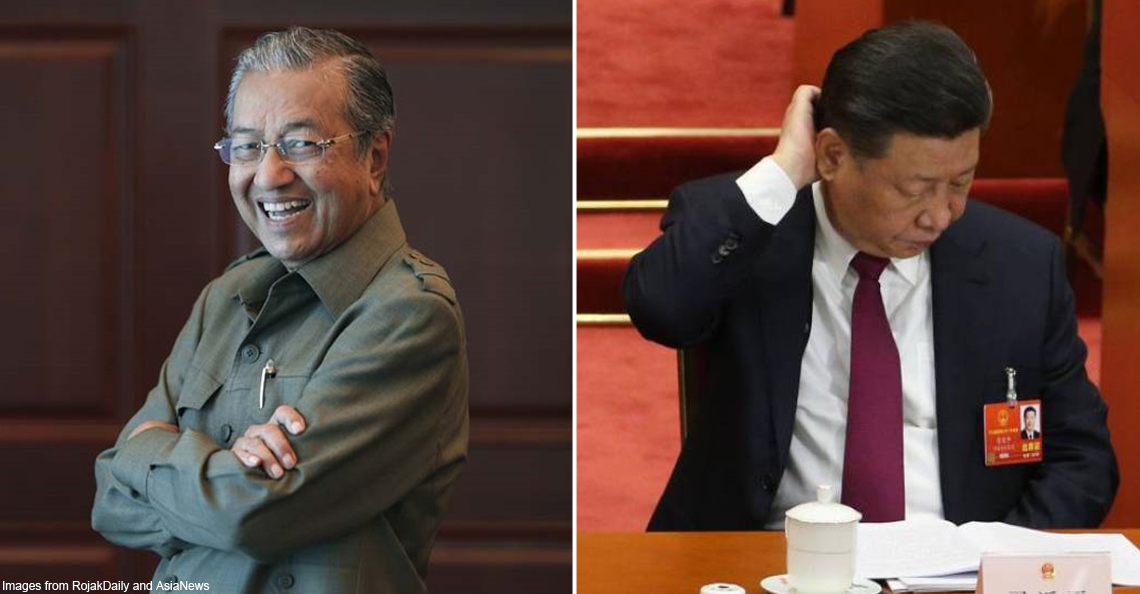How China might have forced Malaysia to keep Lynas

- 704Shares
- Facebook641
- Twitter5
- LinkedIn4
- Email9
- WhatsApp45
Even if you don’t live in Kuantan, you’ve probably heard of a company called Lynas Corp and the controversy surrounding it. Lynas is an Australian company with a plant in Malaysia, and their business is basically extracting something called rare earth elements from a type of ore they mine in Western Australia.
People have protested against Lynas in Malaysia ever since plans to build it in Kuantan were revealed in the early 2010s, not because of what they sell, but because of concerns over the radioactive waste they make in the process, and their alleged lack of plan to handle it.
This waste is called the water leach purification (WLP) residue, and it contains trace amounts of uranium and thorium, both elements classified as ‘weakly radioactive‘. Currently, more than 450,000 tonnes of this WLP is reported to be stockpiled that the Lynas plant in Kuantan.

Despite continued protests by both politicians and NGOs, Lynas had managed to obtain a temporary two-year operating license in 2012, a full stage operating license in 2014, and a license renewal in 2016. Although Lynas’ license is set to expire in September, the government had extended the duration for another six months, drawing outrage among protesters of Lynas.
Last week, an NGO calling itself Save Malaysia Stop Lynas (SMSL) organized a protest attended by some 500 people, whom denounced the government and demanded the resignation of Fuziah Salleh and Wong Tack, MPs for Kuantan and Bentong who had also protested Lynas in the past. They also tore up Promise 39 of the Pakatan manifesto, which basically ensured economic advancement will not come at the cost of the environment and the people.
So why would the new government extend Lynas’ license, despite objections from both inside and outside the government? Well, it may not be the main reason, but you should probably know that…
Lynas is at the centre of a battle between China and the rest of the world
Rare earth elements aren’t exactly rare, but they are found in very tiny concentrations in soil, making them hard to extract and purify. They became very valuable in recent times, having found use as catalysts and materials for supermagnets, in fighter jets and missiles, and in batteries, to name a few. But not many have the technology to produce high-purity rare earth elements outside of China. In fact, a report said that China makes up 85% of the current global production of rare earth elements, with the remaining 15% being produced by Lynas.

With tensions mounting in the US-China trade war (that Huawei issue a while back is part of it), China had considered banning exports of rare earth to the US, something they already did to Japan. Being an alternate supply of rare earth for Japan and the US makes Lynas pretty valuable to these countries. According to economist Barjoyai Bardai, Japan depends on Lynas for one-third of its rare earth needs, and this puts the Pakatan government in a tight (an awkward) spot. On one hand, there’s foreign relations to consider…
“Any disruption to Lynas will affect the Japanese. This, in turn, can affect Malaysia at a time when we are seeking economic assistance from Japan,” – Barjoyai Bardai, to FMT.
…on the other hand, Pakatan politicians had told the public for years that the waste is harmful, so just letting Lynas be won’t solve problems either. While Dr Mahathir had later said that the license extension has nothing to do with Japan, it nevertheless seemed that the situation they were in was like that Malay proverb: ditelan mati emak, diluah mati bapa (damned if you do, damned if you don’t). But they didn’t just blindly extend the license…
The license extension comes with a set of strange conditions
Despite the government granting a license extension to Lynas, it also came with several conditions. These conditions were based on the report of a committee established by the government to address the issue, known as LAMP’s Operations Evaluation Executive Committee. LAMP in this case stands for Lynas Advance Materials Plant, Lynas’ facility in Kuantan. Basically, there are three conditions to be met:
- Moving its cracking and leaching operations outside of Malaysia,
- Find a proper place to keep all their WLP residue, and
- Stop all research and development (particularly on condisoil).
For the first condition, as you can see in this flowchart…

…the cracking and leaching (C&L) process is where the WLP comes from. Lynas is given four years to have a new cracking and leaching facility up and running outside of Malaysia, after which they will no longer be allowed to produce waste more radioactive than 1 Becquerel per gram at the LAMP. This relocation of the C&L process, according to Tan Bun Teet, chairman of Save Malaysia Stop Lynas (SMSL), might make it not feasible economically for Lynas to continue operations at LAMP for several reasons, like logistics and a difference in the price of resources like water.
“We have doubt that the C&L facility, if it is built in Western Australia, will make the operation of Lynas economically viable,” – Tan Bun Teet, in an interview with Cilisos.
However, it would appear that Lynas had already been ready for this one, with plans to relocate their C&L facility to be closer to Mt Weld in Australia revealed in May this year. According to Amanda Lacaze, CEO of Lynas, it will cost USD500 million, but it will ramp up their production and appease Malaysian authorities at the same time.
“This is a sound strategy. It is a sound strategy independent of any other external pressures, but in executing this strategy, which includes the relocation of cracking and leaching from Malaysia, we will also satisfy the Malaysian Government requirements,” – Amanda Lacaze, as reported by Mining.com.
The second condition is a bit more tricky. A Permanent Disposal Facility (PDF) will have to be built to keep the radioactive waste for decades to come, and they have to find a suitable place for it as well as obtaining written permission from the state government involved to use that location. According to Yeo Bee Yin, the land used for a PDF would become ‘permanently unusable‘, and Fauziah Salleh had said that to store all the waste from Lynas, it would require a space ‘100 times more‘ than the one for the Asia Rare Earth (ARE) Facility in Bukit Merah (a radioactive incident which we wrote about here).

Whichever state government consents to Lynas’ PDF request would have to deal with a possible huge swath of unusable land, but according to Amanda Lacaze, the Pahang state government has given them a written approval to locate a PDF in the state. It would seem that Lynas is looking at the possibility of using old abandoned mines in Pahang, and recent media reports suggest that five gold and tin mines in Pahang (Lepar, Luit, Padang Tengku, Bukit Ibam, and Chini) were identified as PDF sites, and studies were being carried out on them.
However, Pahang’s MB Datuk Seri Wan Rosdy had earlier said that they have yet to meet Lynas representatives to discuss that. Regardless of that, the Housing and Local Government Ministry had said that they will work together with the Pahang government to help Lynas with their PDF, and according to its minister, Zuraida Kamaruddin,
“The state government will identify and propose specific land for Lynas to construct the PDF before the ministry takes over. The ministry will look into requirements, including whether the land earmarked is within a suitable distance from housing settlements and the population… Once land related matters are resolved in the next six months, then the other processes can take place,” – Zuraida Kamaruddin, as reported by NST.

The final condition might be a bit confusing if you don’t know what condisoil is, but basically Lynas once tried to deal with its WLP by turning it into some kind of soil conditioner for agriculture, and that’s the condisoil. The research is said to be a success, but there may be underlying risks to using it. Also, according to Prof Datuk Mazlin Mokhtar, one of the committee we mentioned earlier, it’s too soon to tell whether or not it’s safe in the long run.
“Maybe possible (used as fertiliser for agriculture), but the results of research, to date, are not convincing and still require further tests which may take a period of several years more before getting a definitive result,” – Prof Datuk Mazlin Mokhtar, as reported by Malay Mail.
Anyway, that research is to be stopped, and the money earmarked for it (0.5% of Lynas’ gross sales annually) is to be given to the Malaysian government as collateral until the overseas cracking and leaching facility is up and running.
With all these conditions in place, one might wonder…
Are there good reasons to actually keep Lynas?

Even with the seemingly strict conditions in place, some did not seem convinced. Meenakshi Raman, president of Sahabat Alam Malaysia (SAM), had questioned some of the conditions given to Lynas, specifically the 4-year time frame during which Lynas’ operations won’t be suspended.
“This effectively means that the company will be allowed to generate another four years’ of radioactive waste until the operations shift to Australia.” – Meenakshi Raman, as reported by FMT.
An anti-Lynas movement, on the other hand, is preparing a legal team to challenge Lynas’ setting up of their PDF. According to Ronnie Liu (DAP – Sungai Pelek), the PDF will raise its own concerns, including from the local community which he said probably won’t agree with its construction.
With such persistent opposition to Lynas, one might wonder if there are any benefits to keeping them around. The answer to that, it would seem, will be based on whether or not you believe Lynas is dangerous. According to Dr Mahathir, who goes by the view of experts who found nothing dangerous about Lynas, keeping Lynas will benefit Malaysia economically in terms of job creation and foreign investments.
“It is a big investment of RM1.7bil. It creates 700 high-quality, paying jobs. It is necessary for our investment. And if you treat Lynas like a ‘pariah’ and ask them to leave this country, we will not get other people to come into this country to invest,” – Dr Mahathir, as reported by the Star.
But those who believe Lynas is harmful had argued that any possible benefit from Lynas is not worth the risk. We’re not qualified enough to say whether or not Lynas’ risk is real, and the issue is too complex to be condensed into a 2,000-word article anyway. But one way or another, Lynas will have another six months during which they will be monitored by the government to ensure they meet the stated conditions. After that… we’ll just see how it goes.
- 704Shares
- Facebook641
- Twitter5
- LinkedIn4
- Email9
- WhatsApp45



